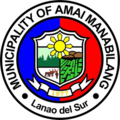This article needs additional citations for verification .(June 2014) |
Amai Manabilang أماي مانابيلانج Bumbaran | |
|---|---|
 Map of Lanao del Sur with Amai Manabilang highlighted | |
 Interactive map of Amai Manabilang | |
Location within the Philippines | |
| Coordinates: 7°47′07″N124°40′56″E / 7.785219°N 124.682339°E | |
| Country | Philippines |
| Region | Bangsamoro Autonomous Region in Muslim Mindanao |
| Province | Lanao del Sur |
| District | 1st district |
| Founded | November 17, 1977 |
| Renamed | January 22, 2015 April 7, 2018 |
| Named after | Amai Manabilang |
| Barangays | 17 (see Barangays) |
| Government | |
| • Type | Sangguniang Bayan |
| • Mayor | Saidamen Leo E. Manabilang |
| • Vice Mayor | Jamal E. Manabilang |
| • Representative | Ziaur-Rahman A. Adiong |
| • Municipal Council | Members |
| • Electorate | 5,825 voters (2025) |
| Area | |
• Total | 544.10 km2 (210.08 sq mi) |
| Elevation | 988 m (3,241 ft) |
| Highest elevation | 1,711 m (5,614 ft) |
| Lowest elevation | 523 m (1,716 ft) |
| Population (2024 census) [3] | |
• Total | 14,837 |
| • Density | 27.269/km2 (70.626/sq mi) |
| • Households | 2,118 |
| Economy | |
| • Income class | 3rd municipal income class |
| • Poverty incidence | 31.97 |
| • Revenue | ₱ 204.6 million (2023) |
| • Assets | ₱ 192.8 million (2023) |
| • Expenditure | ₱ 208.7 million (2023) |
| • Liabilities | ₱ 62.98 million (2023) |
| Service provider | |
| • Electricity | First Bukidnon Electric Cooperative (FIBECO) |
| Time zone | UTC+8 (PST) |
| ZIP code | 9320 |
| PSGC | |
| IDD : area code | +63 (0)63 |
| Native languages | Maranao Tagalog |
| Major religions | Islam, Roman Catholicism |
| Website | www |
Amai Manabilang, officially the Municipality of Amai Manabilang (Maranao: Inged a Amai Manabilang; Tagalog : Bayan ng Amai Manabilang), is a municipality in the province of Lanao del Sur, Philippines. According to the 2020 census, it has a population of 12,124 people. [5]
Contents
- Etymology
- History
- Geography
- Barangays
- Climate
- Demographics
- Religion
- Ethnic groups
- Economy
- References
- External links
The municipality, formerly Bumbaran, was changed to Amai Manabilang under Muslim Mindanao Act No. 316 on January 22, 2015. [6]


